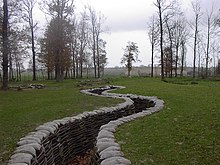Bayernwald
During the First World War, Bayernwald was a military position north of Wijtschate (former name: Wytschaete ) on the Western Front in West Flanders ( Belgium ) from 1914 to 1917 . The position was established by German troops . In 2004 a part of the position was reconstructed and can be visited since then.
location

The position was located approximately in the middle of the 15 km long front bulge of the Wytschaete arch , which was connected to the north of the Ypres arch . It was on a small elevation 40 meters above sea level, from which the enemy territory could be seen. The area of the previous position was in a small forest called Croonaertbos , about two kilometers from Wijtschate to the south.
history
The elevation was taken at the First Battle of Flanders in 1914 after fierce fighting between French and German troops. During the four-year trench warfare , the Germans expanded the position with trenches, trenches and 10 bunkers , which were only 1.2 meters high inside. It is named by the Bavarian units lying there after their military leader in the First Battle of Flanders, Rupprecht von Bayern .

In the vicinity of the position, extensive mining activities developed due to the German and British units located there. Since the British were driving underground shafts for mine explosions in the direction of the German lines, sound shafts around 20 meters deep were dug for eavesdropping in the Bayernwald position.
During the Third Battle of Flanders , the Battle of the Wytschaete Arch caused devastating mine explosions along the Wytschaete Arch . The explosion of 19 mines, with a total of around 400 tons of explosives, which the British detonated on June 7, 1917, was the largest and loudest conventional explosion in human history to date. Almost 10,000 German soldiers were killed within seconds. The Bayernwald position was not directly affected, but the production of Günt about 800 meters southwest with three mine explosions totaling 30,200 kg of ammonal . The explosive craters, which have now been filled with water, are still visible today. After the mine explosions, Allied troops overran the Bayernwald position. The gain in terrain achieved in the advance was only a few kilometers.
restoration
Four buildings of the bunkers have been preserved. The remainder were removed after the First World War for further use of their stone material.
From 2003, the position was restored on the basis of archaeological investigations by the municipality of Heuvelland in cooperation with the non-profit association "ABAF" ( Association for Battlefield Archeology in Flanders ). The cost was around 40,000 euros. The opening ceremony in 2004 was attended by the British and German ambassadors in Belgium and Prince Wolfgang of Bavaria . The restored position is unique in Flanders as it includes a trench system, mine hearing shafts and bunkers.
See also
literature
- F. Bostyn, J. Vancoillie, P. Barton, J. Vandewalle: Bayernwald - Het Croonaertbos in de Eerste Wereldoorlog , 2000
Web links
- Extensive information and photos about the Bayernwald position (Dutch)
- Brief description with aerial photographs
- Brief description with visiting instructions (English)
- Photos of the restored position from 2006
Individual evidence
- ↑ Florian Stark: The biggest conventional explosion hit the Bavarians in: Die Welt from November 20, 2014
- ↑ Aerial view of the Hollandscheshure mine detonation sites
- ↑ The Battle of the Wytschaetebogen. In: The German Army Report of August 5, 1917
- ↑ Bayernwald - Wijtschate - 03/27/2004
- ↑ Bayernwald
- ↑ Opening / Inauguration Bayernwald - Wijtschate - 04/17/2004
Coordinates: 50 ° 48 ′ 5.4 " N , 2 ° 52 ′ 38.6" E

